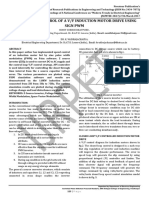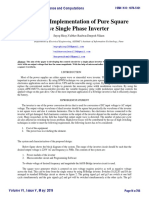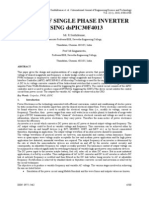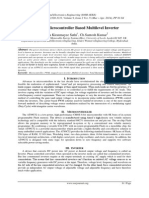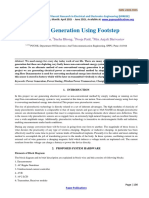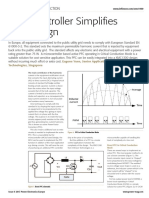Professional Documents
Culture Documents
Modeling of A Pure Sine Wave Power Inverter Using Sinusoidal Pulse Width Modulation (SPWM) Technique
Original Title
Copyright
Available Formats
Share this document
Did you find this document useful?
Is this content inappropriate?
Report this DocumentCopyright:
Available Formats
Modeling of A Pure Sine Wave Power Inverter Using Sinusoidal Pulse Width Modulation (SPWM) Technique
Copyright:
Available Formats
Volume 8, Issue 5, May 2023 International Journal of Innovative Science and Research Technology
ISSN No:-2456-2165
Modeling of a Pure Sine Wave Power Inverter using
Sinusoidal Pulse Width Modulation (SPWM)
Technique
Kelechi Inyama(1), Chinenye Eberechi Uchegbu(2), Ugonna Solomon Alamezie(3)
(1)(2)(3)
Electrical Electronic Engineering Department,
Faculty of Engineering, Abia State University, Uturu, Abia State, Nigeria
Abstract:- Over the years, renewable energy has gained II. LITERATURE REVIEW
a lot of popularity in Nigeria, and Africa as a whole.
Power electronics and converter systems play an The adoption of solar-inverter systems among
important role in the renewable energy sources analysis Nigerians has likely increased over time, making it one of
and modeling. This work provides a discrete modeling the country's most prevalent sources of alternative energy at
and design method for digitally controlled inverters the moment. Also produced locally are inverters by
using software based generation of sinusoidal pulse businesses and individuals. [3].
width modulation. We introduce the background and
foundations of power inverter digital control. For digital There are three major inverter waveform types, Square
pulse-width modulations (PWMs) with delay effects, wave, Modified Sine (MS) wave, and PureSine (PS) wave.
small-signal models are developed. The controllers can Of these, only the last two are commonly seen, as the square
be designed using a variety of models in accordance with wave is considered obsolete. Modified Sine (MS) wave and
the block diagrams based on the models. The Pure Sine (PS) wave generators are the two main power
experimental setting and simulation software for the inverter types available on the Nigerian market today. The
digitally controlled inverters are then described. outputs of these inverters vary, offering various degrees of
efficiency and distortion that might have diverse effects on
Keywords:- Inverter, Pure Sine (PS) wave, Nigeria, electrical equipment. A MS wave is similar to a square wave
Uninterruptible Power Suppliers, Proteus, c++ program, but instead has a “stepping” look to it that relates more in
Arduino. shape to a sine wave [4]. An approximation of a sine wave
may be created by outputting one or more stepped square
I. INTRODUCTION wave with the amplitudes chosen to approximate the sine
[5]. This can be seen in Fig. 1, which displays how a MS
Direct current (DC) and alternating current (AC) are wave tries to emulate the sine wave itself. Notice that as
the two basic types of electrical power. Direct current has time progresses from left to right, the two different
the advantage of being able to be stored in batteries, but waveforms rise at different rates. The MS waveform is
alternating current can have its voltage level changed by simple to create because it only requires switching between
using transformers. three values at predetermined frequencies, omitting the more
intricate circuitry required for a PS wave. The MS wave
In developing countries, shortage of power is a inverter offers a simple and affordable method for powering
problem commercially and domestically [1]. Existing AC-required devices.
electricity production sources are under a heavy pressure
from newly constructed offices. The situation, particularly in
some urban areas, worsens when the quickly rising private
and domestic demand is added. Simply put, we are
becoming more able to consume energy than we are to
produce it. Under these circumstances, failure will happen
suddenly and without notice as a result of strains on the
insufficient power sources. The necessity for an alternate
energy source that can bridge the gap and cover power
supply gaps results from this. Overcoming this obstacle led
to the application of DC/AC power inverters. Short term
solution of power disruption could be addressed through the
use of these inverters and a source of DC power.
An inverter is an electrical system that converts direct
current (d.c) power into an alternating current (a.c) [2].
Components, such as but not limited to transistors, resistors,
Fig. 1: Modified sine wave and pure sine wave
diodes, relays, rectifiers, and switches, can be used to carry
out the inverting operation. Wherever there is a requirement Source: www.altestore.com
to maintain a. c. power in a building or residence, an
inverter can be found.
IJISRT23MAY381 www.ijisrt.com 1561
Volume 8, Issue 5, May 2023 International Journal of Innovative Science and Research Technology
ISSN No:-2456-2165
The inverters constructed in Nigeria which is available Quiet Operation
commercially and also those incorporated in UPS Pure sine wave inverters reduces audible and electrical
(Uninterruptible Power Suppliers) are mostly MS wave noise in fans, fluorescent lights, audio amplifiers, TV, fax
inverters which are not suitable for sophisticated electrical and answering machines.
devices and equipments in daily use due to their output
waveform which constitute of undesirable harmonics [6], Compatibility with a Wide Range of Devices
[7]. Inductive loads like microwave ovens and variable-
speed motors operate properly, quieter and cooler. Some
The modified sine wave is made up of several sine appliances will not produce full output if they do not use
waves with odd harmonics (multiples) of the modified sine Sine-Wave power.
wave's basic frequency. A modified sine wave at 60 Hz, for
instance, will include sine waves with odd harmonic
frequencies like the third (180 Hz), fifth (300 Hz), seventh
(420 Hz), and so on. A modified sine wave's high frequency
harmonic content increases radio interference, increases the
heating effect on motors and microwaves, and causes
overloading by lowering the impedance of low frequency
filter capacitors and power factor improvement capacitors
[8].
A. Need for the Research
A sine-wave inverter's output voltage has a sine
waveform similar to the sine waveform of the mains/utility Fig. 2: Blocks Diagram of Pure Sine Wave Inverter
voltage. In a sine wave inverter, the voltage rises and falls
gradually, the phase angle changes gradually, and the III. MODELING A PURE SINE WAVE INVERTER
polarity changes instantaneously when the voltage reaches 0 USING SOFTWARE GENERATED SMALL
volts. In a modified sine wave, the voltage rises and falls SIGNAL SINUSOIDAL PULSE WIDTH
sharply, the phase angle also shifts sharply, and it remains at MODULATION
0 Volts for some time before switching polarities. Therefore,
any device that uses a control circuitry that senses the phase As power inverters are usually implemented by using
(for voltage/speed control) or instantaneous zero voltage H bridges, describing the output voltage of H bridges as a
crossing (for timing control), will not work properly from a function of the modulation signal is required. The transfer
voltage that has a modified sine wave-form [6]. function of Pulse Width Modulation (PWM) model varies
when different carriers and modulation techniques are used
Having observed the need for producing inverters that [9]. The typical circuit diagram of an H bridge is shown in
can be used to operate sensitive electronic devices that Fig. 3. The output of the H bridge is the filter input voltage
require high quality waveform with little harmonic vin. The switching output is defined as y = vin/Vdc. The
distortion, there is need to establish a proper study on switching output varies significantly when different
modeling and production of a pure sine wave inverter using modulation strategies are used.
simple methods and readily available materials. This can
serve as a tool or guide to Nigerian engineers in the future.
B. Significance of the Research
Same Current as Power Grids
A pure sine wave inverter produces a wave that is very
similar to the smooth wave form generated by mains
electricity. That is, there is no discernible difference between
plugging your devices into these inverters and plugging them
into a wall outlet with power supply from the public power
supply. Fig. 3: A typical H bridge circuit
Minimal Risk to Devices If there are two voltage levels produced on the switch
The smooth wave form produced by a pure sine wave voltage Vin, i.e., Vdc and −Vdc, the H bridge is bipolar
inverter also protects your high-end electronics from damage switched. In order to provide the model for a single-update-
during power outages. Using modified sine wave inverters mode bipolar switched H bridge, we assume that the duty-
with AC-powered devices such as microwaves and ratio is updated at each sampling instant. Therefore, the
refrigerators can generate excessive waste heat, putting your Digital Signal Processor (DSP) delay is one sampling cycle.
devices at risk. Pure sine wave inverters, on the other hand, When the sampling frequency is equal to the switching
pose no threat to any of your devices. frequency, the key waveforms of bipolar switched H-bridge
are shown in figure 4.
IJISRT23MAY381 www.ijisrt.com 1562
Volume 8, Issue 5, May 2023 International Journal of Innovative Science and Research Technology
ISSN No:-2456-2165
IV. SIMULATION
Fig. 4: Key waveforms of single-update-mode uniformly- Fig. 5: Proteus simulation diagram
sampled bipolar switched H-bridge. (a) End-of-on-time
The simulation work of this research is implemented in
modulator. (b) Symmetric-on-time modulator.
Proteus. The digital controllers can be built up by commonly
It can be seen from Fig. 4 that the filter input voltage used classic Proteus models. Then, a c++ program is loaded
frequency of the bipolar switched H-bridge is equivalent to into the controller to model both the switching and carrier
the switching frequency. The duty ratio can be updated only frequency. This frequency is fed into the H-bridge to be
once when using saw-tooth carriers. However, for triangle stepped up to 230V AC.
carriers, the duty-ratio can be updated twice a switching
INPUT STAGE: The input unit consists of sinusoidal
cycle. As the DSP delay from 𝑥∗ to 𝑢∗ is Ts, the small-
pulse width modulation generation from the arduino nano
signal transfer function describing 𝑦𝑏 as a function of xb ∗
microcontroller using a c/c++ program. When simulated it
for end-of-on-time modulator is written as:
could be seen that the two SPWM signal are
𝐺 ∗𝑝𝑤𝑚(𝑠)=𝑇𝑆𝑒 −𝑠(1+𝐷)𝑇𝑠 (3.1) complementary, which connotes that they are 180 degrees
half phase.
On the other hand, for symmetric-on-time modulator,
the small-signal transfer function 𝐺 ∗𝑝𝑤𝑚(𝑠) can be
expressed as
𝐺∗ 𝑇𝑠 −𝑠
(3−𝐷)𝑇𝑠
−𝑠
(3+𝐷)𝑇𝑠 (3.2)
𝑝𝑤𝑚(𝑠)= (𝑒 2 +𝑒 2 )
2
For bipolar switched H bridges, each switching cycle
contains two updated samples with two relevant switching
actions. If the sample is updated at the upper peak of the
(1−𝐷)𝑇𝑠
carrier, the delay from ∗ 𝑡𝑜 𝑦 𝑖𝑠 . On the other hand,
2
if the sample is updated at the lower peak of the carrier, the
𝐷𝑇𝑠
delay from 𝑢∗ to 𝑦𝑏 become . During each switching
2
cycle, the possibilities of the two situations are equal. As the
exact analytical expression of the double-update-mode
PWM model is not easy to obtain, the approximation can be
applied by averaging the two delay effects. With half
switching cycle DSP delay from 𝑥∗ to 𝑦∗, the double
update-mode PWM model of the bipolar switched H-bridge
is given by Fig. 6: Simulated digital small signal of sinusoidal PWM
voltage
𝐺 ∗𝑝𝑤𝑚(𝑠)=𝑇𝑠(𝑒 −𝑠(2−𝐷)𝑇𝑠+𝑒 −𝑠(1+𝐷)𝑇𝑠) (3.3)
4
IJISRT23MAY381 www.ijisrt.com 1563
Volume 8, Issue 5, May 2023 International Journal of Innovative Science and Research Technology
ISSN No:-2456-2165
OUTPUT STAGE: It consists of the final pure sine wave V. APPLICATION
inverter signal. During the test, it can be seen that there
were less harmonics on the sine wave because of the The microcontroller used is ATmega328 in Arduino
inclusion of the LOW pass filter. nano board. This is shown figure 10 below.
Fig. 10: Arduino nano
VI. TESTING THE MODELED PURE SINE WAVE
INVERTER IN PROTEUS
Fig. 7: Simulated output voltage
The Arduino software can be used to program an
Arduino nano. Select the nano board by clicking the Tools
option. The boot loader for the ATmega328 microcontroller
on the Nano board is preprogrammed. With the help of this
boot loader, fresh code can be uploaded without a third-
party hardware programmer. This can be communicated
with via the STK500 protocol. Here, the boot loader can
also be disregarded, and the microcontroller software can be
executed using an Arduino ISP and the in-circuit serial
programming (ICSP) header.
The program is written in C/C++ programming
language. The program is written to generate a small signal
SPWM at its output which is interfaced to H bridge stage of
the inverter. The program is compiled using Arduino
integrated development environment (IDE) and exported as
Hex file. This hex file is imported into the proteus software
Fig. 8: Simulated digital small signal SPWM at MOSFET on the microcontroller model we used. The simulation will
driver and the output voltage not run if there is no code on the microcontroller. Hence,
with the code imported, simulation can commence.
Fig. 9: The simulation environment in Proteus software Fig. 11: Arduino IDE
IJISRT23MAY381 www.ijisrt.com 1564
Volume 8, Issue 5, May 2023 International Journal of Innovative Science and Research Technology
ISSN No:-2456-2165
The simulation diagram in figure 5 is replicated in real A = 0;
life with the H bridge (four MOSFET connected in H Timer1.initialize(t_pwm);
topology) and the step up transformation stage. Of course, Timer1.attachInterrupt(generate_sinus);
the filter stage removes the harmonics on the sinusoidal //samples=(total_sample*2/3);
waves. The complete program for the simulation is shown in Timer1.pwm(outA,(sinus[sample]* A));
appendix A. Timer1.pwm(outB,(sinus[sample]* A));
}
VII. CONCLUSION void loop() {
potinputval = analogRead(potinput);
Although there has been a lot of progress in the field feedbackinputval = analogRead(feedbackinput);
of pure sine wave inverters, the difficulty of producing a while (feedbackinputval < potinputval ) {
waveform with low harmonic content and good efficiency if (A >= max_power) {
remains. There are methods for doing this, but it is potinputval = analogRead(potinput);
necessary to adopt one that is also simple to produce and feedbackinputval = analogRead(feedbackinput);
use, especially for low power applications. This study }
analyzed existing methodologies and attempted to develop a else {
low power application solution that is simple to deploy, A = A + 1;
affordable, and reliable from the consumers' point of view potinputval = analogRead(potinput);
once implemented. We have made an effort to develop an feedbackinputval = analogRead(feedbackinput);
inexpensive design for low power applications. }
This research draws the conclusion that this method is }
an affordable, adaptable, and effective way to design pure while (feedbackinputval>potinputval ) {
sine wave inverters. if (A == 0) {
potinputval = analogRead(potinput);
VIII. APPENDIX A feedbackinputval = analogRead(feedbackinput);
#include <TimerOne.h> }
#define potinput A0 else {
#define feedbackinput A1 A = A - 1;
#define outA 9 potinputval = analogRead(potinput);
#define outB 10 feedbackinputval = analogRead(feedbackinput);
}
int f_pwm =20000;//max 20000 }
int f_sine =50; }
float sinus[200];
float phi=3.14; void generate_sinus(){
generate();
int flag = 0; }
int sample=0,samples=0;
int potinputval; void generate(){
int feedbackinputval;
int A; if(sample>=total_sample && flag==1 ){
int max_power=800;//max 1023 flag=0;
float invert=0.0; sample=1;
int total_sample; //TCCR1A=0b10100000;
int phase =0,x=0;
}
void setup() {
total_sample if(sample>=total_sample && flag==0){
=round((((1000000./f_sine)/(1000000./f_pwm))/2.)); flag=1;
for (int sudut=0;sudut<total_sample;sudut++) sample=1;
{ //TCCR1A=0b10100000;;
float rad= sudut*(180./total_sample)*phi/180; }
sinus[sudut]=sin(rad); sample++;
} if(flag==0){
Timer1.pwm(outA,(sinus[sample]* A));
float t_pwm=(1000000./f_pwm); //PORTB=(0<<PORTB3);
delay(1000); Timer1.pwm(outB,0);
pinMode(potinput, INPUT); }
pinMode(feedbackinput, INPUT); if(flag==1){
pinMode(LED_BUILTIN,OUTPUT); Timer1.pwm(outA,0);
IJISRT23MAY381 www.ijisrt.com 1565
Volume 8, Issue 5, May 2023 International Journal of Innovative Science and Research Technology
ISSN No:-2456-2165
//PORTB=(1<<PORTB3);
Timer1.pwm(outB,(sinus[sample]* A));
}
}
REFERENCES
[1.] Oladimeji T.T. and Okereke C.O. Performance
Analysis of a Branded and Locally Constructed
Modified 1KVA Sine Wave Solar Power Inverter for
Domestic Electric Power Supply. Journal of
Electrical & Electronic Systems 7: 254. 2018. doi:
10.4172/2332-0796.1000254
[2.] A. E. Abioye, M. O. Ogbuatu, M. O. Oluwe, B. O.
Egonwa and K. Ekiokeme. Design and Construction
of 1 KVA Power Inverter System. Journal of
Engineering Research and Reports 2(1): pp.1-14,
2018; Article no.JERR.42644
[3.] “Why Inverters are taking the Lead in Nigeria’s
Search for Alternative Energy Sources”. Crosstech
Nigeria. Retrieved from
https://crosstech.com.ng/why-inverters-are-taking-
the-lead-in-nigerias/
[4.] Jamal A. Mohammed. Performance Study of a
Modified Sine Wave Inverter. Eng. & Tech. Journal,
Vol. 28, No. 2, 2010
[5.] Emira, A.A. & Mohieldin, Ahmed & Sanchez-
Sinencio, E.. A 100MHz, 8mW ROM–less quadrature
direct digital frequency synthesizer. IEEE Journal of
Solid-state Circuits - IEEE J SOLID-STATE
CIRCUITS. 37. 427 - 430. 10.1109/JSSC .2002.
803008.
[6.] Meraj Hasan, Junaid Maqsood, Mirza Qutab Baig,
Syed Murtaza Ali Shah Bukhari, Salman Ahmed.
Design & Implementation of Single Phase Pure Sine
Wave Inverter Using Multivibrator IC. 2015 17th
UKSIM-AMSS International Conference on
Modelling and Simulation
[7.] Ifeagwu N. E., Alor M.,Ugwu C.I., 2016.
Performance Analysis of better Designed Pure Sine
Wave Inverter in Mitigating Frequent Power Outages
in Nigerian Homes. International Journal of Trend in
Research and Development, Volume 3(4), ISSN:
2394-9333
[8.] Sudeep K. Pyakuryal. Control of Harmonics In 6-
Pulse Rectifiers. A Dissertation Presented to the
Faculty of the Daniel Felix Ritchie School of
Engineering and Computer Science, University of
Denver, 2013.
[9.] Praven Palanivel and Subhransu Sekhar Dash.
Multicarrier pulse width modulation methods based
three phase cascaded multilevel inverter including
over modulation and low modulation indices.
Conference: TENCON 2009 - 2009 IEEE Region 10
Conference, February 2009.
IJISRT23MAY381 www.ijisrt.com 1566
You might also like
- Analysis of Single-Phase SPWM Inverter: Sandeep PhogatDocument6 pagesAnalysis of Single-Phase SPWM Inverter: Sandeep PhogatPraneeth MutnuruNo ratings yet
- Chapter One InverterDocument21 pagesChapter One InverterAnonymous EiiiKgTCNo ratings yet
- Single Phase PWM InverterDocument56 pagesSingle Phase PWM InverterMary Paulson100% (2)
- Hastings-Emurashe - Project (Correction)Document21 pagesHastings-Emurashe - Project (Correction)HASTINGS EMURASHENo ratings yet
- Ijrras 5 3 11 PDFDocument11 pagesIjrras 5 3 11 PDFAnonymous D4qnTh7fNo ratings yet
- Simulation of Inverter Circuit Using MulDocument11 pagesSimulation of Inverter Circuit Using MulVijith SatishNo ratings yet
- Introduction to Inverters and Their ClassificationsDocument41 pagesIntroduction to Inverters and Their Classificationsashutosh chaurasiaNo ratings yet
- Development of Pure Sine Wave Inversion System With Inbuilt Charging and Display MechanismsDocument6 pagesDevelopment of Pure Sine Wave Inversion System With Inbuilt Charging and Display MechanismsHector OrozcoNo ratings yet
- Microcontroller Based Solar Power Inverter: Ruchika Thukral, Ankit Gupta, Nilesh Kumar Verma, Shivanchal AsthanaDocument9 pagesMicrocontroller Based Solar Power Inverter: Ruchika Thukral, Ankit Gupta, Nilesh Kumar Verma, Shivanchal AsthanaBubai BhattacharyyaNo ratings yet
- Design and Construction of A Pure Sine Wave InverterDocument8 pagesDesign and Construction of A Pure Sine Wave InverterAlvaro Javier Baños Rivera100% (1)
- Analog PWM Tri GenDocument12 pagesAnalog PWM Tri GenDavid BedoyaNo ratings yet
- Design of SPWM Based Three Phase Inverter Model: Tanuhsree Bhattacharjee Dr. Majid Jamil Dr. Anup JanaDocument6 pagesDesign of SPWM Based Three Phase Inverter Model: Tanuhsree Bhattacharjee Dr. Majid Jamil Dr. Anup JanaandersonNo ratings yet
- Lab Project ReportDocument11 pagesLab Project ReportMe alag HuNo ratings yet
- Art05 IDocument12 pagesArt05 IArsyad CahyaNo ratings yet
- Simulation of Dc/Ac Pure Sinewave Inverter and Analysis On Different Swtching TechniquesDocument10 pagesSimulation of Dc/Ac Pure Sinewave Inverter and Analysis On Different Swtching TechniquesthettinNo ratings yet
- UKSim 2015 58Document5 pagesUKSim 2015 58october87No ratings yet
- Matlab Simulink Model of Sinusoidal PWM For Three-Phase Voltage Source InverterDocument3 pagesMatlab Simulink Model of Sinusoidal PWM For Three-Phase Voltage Source InverterEditor IJTSRDNo ratings yet
- AC/DC Conversion and Inverter DesignDocument31 pagesAC/DC Conversion and Inverter DesignshahidullahNo ratings yet
- How Does A Power Inverter Work?: Inverters Can Also Be Used With Transformers To Change A Certain DC Input Voltage IntoDocument15 pagesHow Does A Power Inverter Work?: Inverters Can Also Be Used With Transformers To Change A Certain DC Input Voltage Intoshubham choudharyNo ratings yet
- Trofazni Invertor SPWMDocument6 pagesTrofazni Invertor SPWMBorislav BrnjadaNo ratings yet
- Switching Control of Inverter Using SPWM Technique: © 2015 IJIRT - Volume 1 Issue 12 - ISSN: 2349-6002Document8 pagesSwitching Control of Inverter Using SPWM Technique: © 2015 IJIRT - Volume 1 Issue 12 - ISSN: 2349-6002WasimNo ratings yet
- Induction Motor ControlDocument5 pagesInduction Motor ControlJournalNX - a Multidisciplinary Peer Reviewed JournalNo ratings yet
- Unipolar and Bipolar SPWM Voltage Modula PDFDocument5 pagesUnipolar and Bipolar SPWM Voltage Modula PDFĐorđe ĐurđićNo ratings yet
- Design and Implementation of Pure Square Wave Single Phase InverterDocument4 pagesDesign and Implementation of Pure Square Wave Single Phase Invertergiramach getahunNo ratings yet
- Mega Synopsis - RemovedDocument5 pagesMega Synopsis - Removedaabailmuzemar128No ratings yet
- DC Ac Pure Sine Wave Inverter With MinimDocument66 pagesDC Ac Pure Sine Wave Inverter With MinimKang Aryo100% (1)
- Selection of Various Types of Inverter - (Part-1) - Electrical Notes & ArticlesDocument8 pagesSelection of Various Types of Inverter - (Part-1) - Electrical Notes & ArticlesRahul ItaliyaNo ratings yet
- IJIRSTV7I10013Document8 pagesIJIRSTV7I10013rahim oneNo ratings yet
- Power Efficient Mini InverterDocument2 pagesPower Efficient Mini InverterLeo S.SNo ratings yet
- Design 1.5kVA PWM InverterDocument13 pagesDesign 1.5kVA PWM Invertershah pallav pankaj kumarNo ratings yet
- Design of Single Phase Inverter Using Dspic30F4013: Mr. R.SenthilkumarDocument7 pagesDesign of Single Phase Inverter Using Dspic30F4013: Mr. R.SenthilkumarsureshhdreamNo ratings yet
- Analysis Hardware Implementation of Three Phase Voltage Source Inverter IJERTV2IS50796Document10 pagesAnalysis Hardware Implementation of Three Phase Voltage Source Inverter IJERTV2IS50796Paul Mathew 21PHD1086No ratings yet
- Performance Analysis of Phase Shifted SPWM Technique For Three Phase Diode Clamped Three Level InverterDocument5 pagesPerformance Analysis of Phase Shifted SPWM Technique For Three Phase Diode Clamped Three Level InverterElea JackNo ratings yet
- Research of Single-Phase Inverter For PV Modules With MPPTDocument4 pagesResearch of Single-Phase Inverter For PV Modules With MPPTAl Bajad MamadNo ratings yet
- InvertersDocument8 pagesInvertersJeffrey A PobladorNo ratings yet
- Tugas EldaDocument7 pagesTugas EldaDede RilwanNo ratings yet
- Project 2Document13 pagesProject 2SAYYAMNo ratings yet
- Microcontrollers ApplicationDocument7 pagesMicrocontrollers Applicationer_ravi5No ratings yet
- Irjet V5i3422Document4 pagesIrjet V5i3422NEROB KUMAR MOHONTO XRLNZGkUXmNo ratings yet
- Chapter OneDocument28 pagesChapter OneObafemi Samuel0% (1)
- Design and Simulation of an Inverter With High Frequency Sinusoidal PWM Switching Technique for Harmonic Reduction in a Standalone Utility Grid Harmonic Reduction in a Standalone Utility Grid Synchronized Photovoltaic SystemDocument6 pagesDesign and Simulation of an Inverter With High Frequency Sinusoidal PWM Switching Technique for Harmonic Reduction in a Standalone Utility Grid Harmonic Reduction in a Standalone Utility Grid Synchronized Photovoltaic SystemS.m. FerdousNo ratings yet
- Advanced InvertersDocument30 pagesAdvanced InvertersShivam VermaNo ratings yet
- BBGDocument8 pagesBBGGrandeurNo ratings yet
- Design of Microcontroller Based Multilevel InverterDocument4 pagesDesign of Microcontroller Based Multilevel InverterInternational Organization of Scientific Research (IOSR)No ratings yet
- Design of Sinusoidal Pulse Width Modulation 3 Phase Bridge InverterDocument4 pagesDesign of Sinusoidal Pulse Width Modulation 3 Phase Bridge InverterLawson SangoNo ratings yet
- The Design and Construction of A 1kva Inverter 49596Document11 pagesThe Design and Construction of A 1kva Inverter 49596Emmanuel KutaniNo ratings yet
- Complete INVERTER ProjectDocument34 pagesComplete INVERTER Projectalfred adukobirre adukobilla71% (17)
- DC 12V To 220V Ac Inverter Making by Using Ic CD4047Document19 pagesDC 12V To 220V Ac Inverter Making by Using Ic CD4047Amartya RoyNo ratings yet
- Sine Inverter Controller With 8 Bit MicrocontrollerDocument8 pagesSine Inverter Controller With 8 Bit MicrocontrollerBillGNo ratings yet
- Imp - A Survey On Neutral-Point-Clamped InvertersDocument12 pagesImp - A Survey On Neutral-Point-Clamped InvertersVenkataramdas BonamNo ratings yet
- Single Phase AC To AC Conversion Without Frequency RestrictionsDocument4 pagesSingle Phase AC To AC Conversion Without Frequency RestrictionsTaniyaNo ratings yet
- DC AC InvertorDocument61 pagesDC AC InvertorPaul TodericNo ratings yet
- A6 - Three Phase Inverter PDFDocument40 pagesA6 - Three Phase Inverter PDFPedro Carvalho100% (2)
- Report DSD 2.0Document13 pagesReport DSD 2.0gojoNo ratings yet
- Project 2Document12 pagesProject 2SAYYAMNo ratings yet
- ICEM2020Document8 pagesICEM2020marinkokNo ratings yet
- Power Generation Using Footstep-310Document5 pagesPower Generation Using Footstep-310LavanyaNo ratings yet
- DC to AC power inverter design and output waveformsDocument4 pagesDC to AC power inverter design and output waveformsMohamed AbubackerNo ratings yet
- Trilogy of Wireless Power: Basic principles, WPT Systems and ApplicationsFrom EverandTrilogy of Wireless Power: Basic principles, WPT Systems and ApplicationsNo ratings yet
- Reference Guide To Useful Electronic Circuits And Circuit Design Techniques - Part 1From EverandReference Guide To Useful Electronic Circuits And Circuit Design Techniques - Part 1Rating: 2.5 out of 5 stars2.5/5 (3)
- Diabetic Retinopathy Stage Detection Using CNN and Inception V3Document9 pagesDiabetic Retinopathy Stage Detection Using CNN and Inception V3International Journal of Innovative Science and Research TechnologyNo ratings yet
- Exploring the Molecular Docking Interactions between the Polyherbal Formulation Ibadhychooranam and Human Aldose Reductase Enzyme as a Novel Approach for Investigating its Potential Efficacy in Management of CataractDocument7 pagesExploring the Molecular Docking Interactions between the Polyherbal Formulation Ibadhychooranam and Human Aldose Reductase Enzyme as a Novel Approach for Investigating its Potential Efficacy in Management of CataractInternational Journal of Innovative Science and Research TechnologyNo ratings yet
- Investigating Factors Influencing Employee Absenteeism: A Case Study of Secondary Schools in MuscatDocument16 pagesInvestigating Factors Influencing Employee Absenteeism: A Case Study of Secondary Schools in MuscatInternational Journal of Innovative Science and Research TechnologyNo ratings yet
- An Analysis on Mental Health Issues among IndividualsDocument6 pagesAn Analysis on Mental Health Issues among IndividualsInternational Journal of Innovative Science and Research TechnologyNo ratings yet
- Harnessing Open Innovation for Translating Global Languages into Indian LanuagesDocument7 pagesHarnessing Open Innovation for Translating Global Languages into Indian LanuagesInternational Journal of Innovative Science and Research TechnologyNo ratings yet
- The Utilization of Date Palm (Phoenix dactylifera) Leaf Fiber as a Main Component in Making an Improvised Water FilterDocument11 pagesThe Utilization of Date Palm (Phoenix dactylifera) Leaf Fiber as a Main Component in Making an Improvised Water FilterInternational Journal of Innovative Science and Research TechnologyNo ratings yet
- Advancing Healthcare Predictions: Harnessing Machine Learning for Accurate Health Index PrognosisDocument8 pagesAdvancing Healthcare Predictions: Harnessing Machine Learning for Accurate Health Index PrognosisInternational Journal of Innovative Science and Research TechnologyNo ratings yet
- The Relationship between Teacher Reflective Practice and Students Engagement in the Public Elementary SchoolDocument31 pagesThe Relationship between Teacher Reflective Practice and Students Engagement in the Public Elementary SchoolInternational Journal of Innovative Science and Research TechnologyNo ratings yet
- The Making of Object Recognition Eyeglasses for the Visually Impaired using Image AIDocument6 pagesThe Making of Object Recognition Eyeglasses for the Visually Impaired using Image AIInternational Journal of Innovative Science and Research TechnologyNo ratings yet
- Design, Development and Evaluation of Methi-Shikakai Herbal ShampooDocument8 pagesDesign, Development and Evaluation of Methi-Shikakai Herbal ShampooInternational Journal of Innovative Science and Research Technology100% (3)
- Dense Wavelength Division Multiplexing (DWDM) in IT Networks: A Leap Beyond Synchronous Digital Hierarchy (SDH)Document2 pagesDense Wavelength Division Multiplexing (DWDM) in IT Networks: A Leap Beyond Synchronous Digital Hierarchy (SDH)International Journal of Innovative Science and Research TechnologyNo ratings yet
- Terracing as an Old-Style Scheme of Soil Water Preservation in Djingliya-Mandara Mountains- CameroonDocument14 pagesTerracing as an Old-Style Scheme of Soil Water Preservation in Djingliya-Mandara Mountains- CameroonInternational Journal of Innovative Science and Research TechnologyNo ratings yet
- The Impact of Digital Marketing Dimensions on Customer SatisfactionDocument6 pagesThe Impact of Digital Marketing Dimensions on Customer SatisfactionInternational Journal of Innovative Science and Research TechnologyNo ratings yet
- Formulation and Evaluation of Poly Herbal Body ScrubDocument6 pagesFormulation and Evaluation of Poly Herbal Body ScrubInternational Journal of Innovative Science and Research TechnologyNo ratings yet
- Electro-Optics Properties of Intact Cocoa Beans based on Near Infrared TechnologyDocument7 pagesElectro-Optics Properties of Intact Cocoa Beans based on Near Infrared TechnologyInternational Journal of Innovative Science and Research TechnologyNo ratings yet
- Comparatively Design and Analyze Elevated Rectangular Water Reservoir with and without Bracing for Different Stagging HeightDocument4 pagesComparatively Design and Analyze Elevated Rectangular Water Reservoir with and without Bracing for Different Stagging HeightInternational Journal of Innovative Science and Research TechnologyNo ratings yet
- Auto Encoder Driven Hybrid Pipelines for Image Deblurring using NAFNETDocument6 pagesAuto Encoder Driven Hybrid Pipelines for Image Deblurring using NAFNETInternational Journal of Innovative Science and Research TechnologyNo ratings yet
- Review of Biomechanics in Footwear Design and Development: An Exploration of Key Concepts and InnovationsDocument5 pagesReview of Biomechanics in Footwear Design and Development: An Exploration of Key Concepts and InnovationsInternational Journal of Innovative Science and Research TechnologyNo ratings yet
- A Survey of the Plastic Waste used in Paving BlocksDocument4 pagesA Survey of the Plastic Waste used in Paving BlocksInternational Journal of Innovative Science and Research TechnologyNo ratings yet
- Hepatic Portovenous Gas in a Young MaleDocument2 pagesHepatic Portovenous Gas in a Young MaleInternational Journal of Innovative Science and Research TechnologyNo ratings yet
- Explorning the Role of Machine Learning in Enhancing Cloud SecurityDocument5 pagesExplorning the Role of Machine Learning in Enhancing Cloud SecurityInternational Journal of Innovative Science and Research TechnologyNo ratings yet
- Cyberbullying: Legal and Ethical Implications, Challenges and Opportunities for Policy DevelopmentDocument7 pagesCyberbullying: Legal and Ethical Implications, Challenges and Opportunities for Policy DevelopmentInternational Journal of Innovative Science and Research TechnologyNo ratings yet
- Automatic Power Factor ControllerDocument4 pagesAutomatic Power Factor ControllerInternational Journal of Innovative Science and Research TechnologyNo ratings yet
- Navigating Digitalization: AHP Insights for SMEs' Strategic TransformationDocument11 pagesNavigating Digitalization: AHP Insights for SMEs' Strategic TransformationInternational Journal of Innovative Science and Research TechnologyNo ratings yet
- Studying the Situation and Proposing Some Basic Solutions to Improve Psychological Harmony Between Managerial Staff and Students of Medical Universities in Hanoi AreaDocument5 pagesStudying the Situation and Proposing Some Basic Solutions to Improve Psychological Harmony Between Managerial Staff and Students of Medical Universities in Hanoi AreaInternational Journal of Innovative Science and Research TechnologyNo ratings yet
- Mobile Distractions among Adolescents: Impact on Learning in the Aftermath of COVID-19 in IndiaDocument2 pagesMobile Distractions among Adolescents: Impact on Learning in the Aftermath of COVID-19 in IndiaInternational Journal of Innovative Science and Research TechnologyNo ratings yet
- A Review: Pink Eye Outbreak in IndiaDocument3 pagesA Review: Pink Eye Outbreak in IndiaInternational Journal of Innovative Science and Research TechnologyNo ratings yet
- Drug Dosage Control System Using Reinforcement LearningDocument8 pagesDrug Dosage Control System Using Reinforcement LearningInternational Journal of Innovative Science and Research TechnologyNo ratings yet
- The Effect of Time Variables as Predictors of Senior Secondary School Students' Mathematical Performance Department of Mathematics Education Freetown PolytechnicDocument7 pagesThe Effect of Time Variables as Predictors of Senior Secondary School Students' Mathematical Performance Department of Mathematics Education Freetown PolytechnicInternational Journal of Innovative Science and Research TechnologyNo ratings yet
- Formation of New Technology in Automated Highway System in Peripheral HighwayDocument6 pagesFormation of New Technology in Automated Highway System in Peripheral HighwayInternational Journal of Innovative Science and Research TechnologyNo ratings yet
- Amoi Lc26t1e 32t1e 37t1e 42t1e (ET)Document120 pagesAmoi Lc26t1e 32t1e 37t1e 42t1e (ET)Dimitris ApostolouNo ratings yet
- Operating Manual MHS-5200A Series Dual-Channel DDS Signal GeneratorDocument20 pagesOperating Manual MHS-5200A Series Dual-Channel DDS Signal Generatorsempreaprender3701No ratings yet
- Calibration Procedure For Pulse Function Arbitrary Noise Generator, Agilent Model 81150a - Tb-9-6625-2402-24Document35 pagesCalibration Procedure For Pulse Function Arbitrary Noise Generator, Agilent Model 81150a - Tb-9-6625-2402-24luroguita100% (2)
- Project Ideas ECE StudentsDocument51 pagesProject Ideas ECE StudentsVatsal N ShahNo ratings yet
- Speed Control of Induction MotorDocument33 pagesSpeed Control of Induction MotorMaham NaeemNo ratings yet
- Pulse-Width Modulated Rectifiers: Fundamentals of Power Electronics Chapter 18: PWM RectifiersDocument100 pagesPulse-Width Modulated Rectifiers: Fundamentals of Power Electronics Chapter 18: PWM RectifiersMohammad Faizal RamdhaniNo ratings yet
- Infineon Feature06 Layout 1Document2 pagesInfineon Feature06 Layout 1John Walter Ticona QuispeNo ratings yet
- Programmable: Polyphonic SynthesizerDocument36 pagesProgrammable: Polyphonic SynthesizerDeolinda Maria Saraiva GarizoNo ratings yet
- Re 98081Document6 pagesRe 98081JorGeh LinkinParkNo ratings yet
- Modulation Techniques Questions and Answers GuideDocument12 pagesModulation Techniques Questions and Answers Guidera1No ratings yet
- Project Report On Pick and Place Robot (By Chirag Joshi)Document37 pagesProject Report On Pick and Place Robot (By Chirag Joshi)Chirag85% (41)
- S54 Swap WiringDocument5 pagesS54 Swap WiringStevan AritonovicNo ratings yet
- FSB 50450Document8 pagesFSB 50450JundiyahNo ratings yet
- Wabco Atc CanDocument36 pagesWabco Atc CanCostel Caraman100% (1)
- Unit2 ARMDocument38 pagesUnit2 ARMKONASANI HARSHITH (RA2011004010349)No ratings yet
- Dc02en PDFDocument42 pagesDc02en PDFKaya EmanuelNo ratings yet
- 2016 - Python Based 3-Axis CNC PlotterDocument5 pages2016 - Python Based 3-Axis CNC PlotterSachin ShindeNo ratings yet
- 232M200MANDocument24 pages232M200MANapi-3723964100% (1)
- Design of Solar Powered Induction Motor Drive For Pumping ApplicationDocument10 pagesDesign of Solar Powered Induction Motor Drive For Pumping ApplicationDHRUV UPADHAYANo ratings yet
- Laptop Inverter CCFLDocument2 pagesLaptop Inverter CCFLbingolahNo ratings yet
- Step-Down Chopper Overview and ProceduresDocument4 pagesStep-Down Chopper Overview and ProceduresJayakumar ThangavelNo ratings yet
- Communication Lab-I PDFDocument27 pagesCommunication Lab-I PDFsathyanandmurikkoliNo ratings yet
- Datasheet PDFDocument16 pagesDatasheet PDFRaul LeonNo ratings yet
- Product Information MI03-S-XX-XXX V1.5Document2 pagesProduct Information MI03-S-XX-XXX V1.5Jorge MorenoNo ratings yet
- PL2303TB USB-to-Serial Bridge Controller Demo Board User ManualDocument17 pagesPL2303TB USB-to-Serial Bridge Controller Demo Board User ManualAda CsabaNo ratings yet
- Mar Vell 88MC200 - Microcontroller - Datasheet - Rev - B PDFDocument754 pagesMar Vell 88MC200 - Microcontroller - Datasheet - Rev - B PDFFranklin JimenezNo ratings yet
- Micropython PyboardDocument197 pagesMicropython PyboardSyed Mohiuddin ZiaNo ratings yet
- SSD1960 Application Note v1.3Document32 pagesSSD1960 Application Note v1.3KrishNo ratings yet
- Implementation of PWM Based Firing Scheme For Multilevel Inverter Using MicrocontrollerDocument10 pagesImplementation of PWM Based Firing Scheme For Multilevel Inverter Using MicrocontrollerSaqib RanaNo ratings yet
- Variable Frequency Drives PDFDocument123 pagesVariable Frequency Drives PDFRajeevAgrawal67% (3)





















